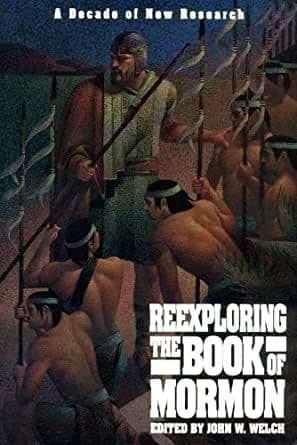Book
85 Chapters

Alma 43:3 “And now I return to an account of the wars between the Nephites and the Lamanites.”
On August 21-22, 1987, F.A.R.M.S. sponsored a working conference in Provo. Chaired by Stephen Ricks and William Hamblin, twelve participants, plus a few observers, came from as far away as California, Missouri, and Mississippi. Over a day and a half of concentrated activity, this group project involved formal presentation of written work.
Even though warfare plays an especially prominent role in several sections of the Book of Mormon, what is known about the armies, weapons, strategies, fortifications, captives, rituals, causes, and results of war reported in the scripture has never been comprehensively examined. One task of this conference was to develop an agenda of those topics that merit scrutiny.
The first presentations dealt with military technology and organization. Brent Merrill gave two papers, one on swords and cimeters, and the other on Nephite captains and their role in military organization. He noted that the office of chief captain apparently emerged when Alma split the chief judgeship into three separate offices (see Alma 4:20; 16:5).
William Hamblin examined all descriptions of the bow and arrow in the Book of Mormon, relating them to a wide variety of archaeological and art evidence from the Near East and Mesoamerica. One interesting observation was that the Hebrew idiom for “shooting” an arrow literally also means “throwing”; thus Alma 49:22 refers to arrows “thrown” at the Lamanites.
John Sorenson summarized the dramatic shift that has occurred in thought about warfare in studies on Mesoamerica in recent decades. Where scholars once saw utopian peace prevailing throughout ancient Mesoamerica, now at least a hundred fortified sites have been identified, and the pervasive role of war in Mesoamerican life over at least two thousand years is widely recognized.
Bruce Warren compared a number of war practices and beliefs thought to have prevailed in the Maya civilization to practices and beliefs of the Nephites and Jaredites, especially the reasons for imprisoning or killing kings. Matthew Hilton looked at reasons and motivations for war in the modern world and compared them with concepts of freedom, peace, righteousness, and just war in the Book of Mormon.
Gordon Thomasson suggested that certain rituals were associated with warfare in the Book of Mormon, as may be evidenced by the slaying of Amalickiah (see Alma 51:34-52:2) and Ammoron (see Alma 62:36-39) immediately before royally important new year’s days.
Evidence for martial law among the Nephites was presented by John Welch and Robert Eaton. As in Israel, law and war interact in several ways in the Book of Mormon, as in justifying and controlling the use of military force, suspending the normal judicial process (see Alma 51:19), imposing civic and international obligations, and prescribing treatment of prisoners of war.
John Tvedtnes examined tribal and political affiliations within the Book of Mormon and proposed that leaders of Nephite armies were drawn from particular lineage groups or a military caste. This would explain why Moroni at age twenty-five (see Alma 43:17), his son Moronihah at about age eighteen (see Alma 62:39), Mormon at age sixteen (see Mormon 2:2), and others in this line or group were made chief captains while surprisingly young.
Terrence Szink presented several parallels between the ritual behavior of Moroni’s soldiers when he raised the banner of liberty and ancient Near Eastern practices. A Hittite soldier’s oath offered an intriguing counterpart to the Nephite soldier’s covenant in Alma 46:21-22. Finally, Daniel Peterson gave an insightful interpretation of the Gadianton Robbers as a counterculture. He pointed out ways we fail to understand their motives and practices.
Following this Update, which appeared in September 1987, F.A.R.M.S. sponsored a formal conference on warfare in the Book of Mormon in the Spring of 1989, at which time finished versions of these projects and additional papers were presented. They were then published in Stephen Ricks and William Hamblin, eds., Warfare in the Book of Mormon (Salt Lake City: Deseret Book and F.A.R.M.S., 1990), the first topical Book of Mormon treatise of its kind. This significant and informative historical treatment is discussed further with additional substantive research in two reviews by David B. Honey and Kurt Weiland, in Review of Books on the Book of Mormon 3 (1991): 118-46.
Book
85 Chapters
Items in the BMC Archive are made publicly available for non-commercial, private use. Inclusion within the BMC Archive does not imply endorsement. Items do not represent the official views of The Church of Jesus Christ of Latter-day Saints or of Book of Mormon Central.